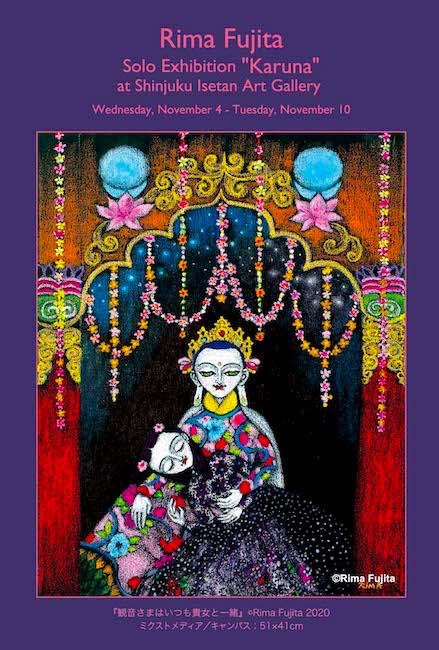Rima Fujita is a long-time painter of Buddhist art with a distinctive style that focuses on vivid colours and fairytale-like landscapes and figures. A keen devotee of Avalokiteshvara, the bodhisattva of compassion, she is holding a solo exhibition titled “Karuna” at Isetan Art Gallery in Shinjuku, Tokyo. We caught up with Rima to learn more about the themes of her new exhibit.
RL: Not only is karuna the theme of your exhibit, but Avalokiteshvara often appears to you in your dreams. Why do you think you have such affinity with the embodiment of compassion?
RF: I don’t really know why, but perhaps because those few reasons:
I grew up in Japan until I was 14 before moving to New York City, and Kannon Bosatsu (Avalokiteshvara) was a familiar deity in my daily life. In Japan Avalokiteshvara is perceived rather as a female deity who is very gracious, beautiful and filled with compassion, and I’ve always felt comfortable around the images of this bodhisattva. On the contrary, I was a bit intimidated by the Buddha statues in Japan that tend to look more stoic and austere due to the Japanese artistic style of the Buddha sculptures.
The other reason may be the fact that His Holiness the Dalai Lama, my root guru, is believed to be the manifestation of Avalokiteshvara (Chenrezig) by the Tibetans.

I have a very special and deep connection with this Avalokiteshvara statue called, “Kiron Jowo Wati Sanpo,” that is a Tibetan national treasure. It’s open to the public view only once a year, and it’s been kept at The Dalai Lama’s monastery in Dharamsala. When I first saw the photo of this exquisite statue I got goosebumps all over my body and my heart began beating so fast. The intense emotion I experienced was bizarre. I felt a deep connection with this statue.
Then, sometimes later, a photograph of this beautiful statue with HHDL’s autographs on it was given to me, and I began praying and meditating in front of this photograph every day. The funny thing is that the expression of this Avalokiteshvara changes often, and when I heard HHDL talk about this statue I couldn’t resist chuckling. HHDL said, “The expression of this statue often changes, and when this Avalokiteshvara wants to talk to me he blinks his eyes very quickly to get my attention!”

RL: Talk a bit about how you conceived of the visual and emotional dynamic between the subjects (girls and women) and the Avalokiteshvara figures in the paintings.
RF: My creative method is rather strange – I paint the visions I see in my dreams and meditations. In my dreams I see the images of my finished paintings before I actually paint them. Therefore, I don’t know the meaning of those visions, but they usually convey important messages.
There is a woman (or a girl) in most of the visions I see in my dreams. I don’t know who she is, but she may be my alter-ego or she could be myself in another life. I see her as a messenger who brings important messages to me, and my job is to convey those messages by creating art. I believe that the woman is a messenger of Avalokiteshvara and the woman is connecting us with the Bodhisattva of Compassion.

RL. Talk a bit about the notion of healing, brokenness, and compassion in your dreams and how they inspire the aesthetics of this exhibit’s paintings.
RF: The pandemic has affected all of us in the world, and many of us have been facing many challenges. On top of that we all have our personal challenges to deal with. We are all suffering, and we all need compassion for ourselves and for others. Things naturally get healed over time, but some things require extra work. Compassion heals wounds and pains. Compassion allows you to love yourself and others. Compassion helps you forgive yourself and others. These are the messages that came through my dreams, therefore, the theme of my exhibition has become “Karuna” – compassion in Sanskrit.
I myself have survived this difficult season of uncertainty with daily meditation and prayer, and creating art has kept me sane.

RL: More generally, how has the pandemic affected the Buddhist art world (specifically, contemporary Buddhist artists)?
RF: The art world in general has been hit hard by this pandemic as many museums and galleries have been closed, and many artists have lost projects and sales. A couple of my exhibitions have been cancelled in the US and my giant mural project in Los Angeles has been pending. So I am deeply affected by this pandemic, too.
However, as Buddhist artists we all have to remind ourselves that we are in samsara. And we have to keep reminding ourselves of the teachings of Impermanence and Emptiness, and keep creating art.
Personally, this pandemic wouldn’t stop me from creating because it is my mission to create to bring awareness to the world. As an artist I turn this painful time into positive fuel to create something beautiful in order to bring peace and joy back into the troubled world.

See more


[…] Visuals of Compassion: Artist Rima Fujita on her new exhibit, “Karuna”Rima Fujita: Art and Action […]